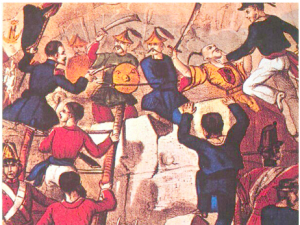 By Pamela Toler (Regular Contributor)
By Pamela Toler (Regular Contributor)
A growing number of addicts. A ruthless business cartel. A country determined to close its borders to imported drugs. Violence and corruption in major cities. Sound familiar?
Welcome to the Opium War of 1839.
Opium: A Business Plan
In the late eighteenth century, opium was a key element in the British East India Company’s business plan. The company grew opium in India and sold it in China, using the proceeds to pay for porcelain, tea and silk for the market back home in Britain. By the 1820s, the British were shipping enough opium to China each year to supply a million addicts, and the market was growing.
The Chinese government rightly saw imported opium as a threat to society. Opium smoking not only destroyed individuals, it destroyed families. (You want a lecture on family values? Read Confucius.) The high price of opium led to violence and corruption. The drain of silver payments for opium threatened the country’s economic base. The Chinese made the import and production of opium illegal in 1800, but their efforts to enforce the ban were unsuccessful.
Britain, in its turn, wanted China opened up to free trade. The Chinese limited foreign trade to the port of Canton (now Guangzhou). Within Canton, foreign merchants were subject to further limitations on where they could live and trade, when they could trade, and who they could trade with. In 1793 , the British government sent Lord George McCartney on diplomatic mission to China with the goals of establishing diplomatic relationships with the Chinese government and opening trade. The Chinese Emperor sent a condescending note to King George III explaining his refusal: “We have never valued ingenious articles, nor do we have the slightest need of your country’s manufacture.” A second mission in 1816 under the leadership of Lord Amherst was dismissed by the Chinese due to Amherst’s refusal to follow the ceremonial forms of the Chinese court.
A Drug Tsar by Any Other Name
In 1838, the Emperor sent an Imperial Commissioner to Canton to stop the opium trade–basically a drug tsar by another name. Lin Zexu successfully suppressed the Chinese opium sellers, but was forced to barricade the foreigners in their warehouses before they surrendered their merchandise.
Lin Zexu confiscated and destroyed 20,000 chests of illegal opium from British warehouses. The British responded by sending sixteen British warships to China. Between 1839 and 1842, the British navy attacked and blockaded Chinese ports, sank Chinese ships, occupied Shanghai, and sailed up the Yangzte River to threaten the city of Nanjing. Their immediate goal was ‘”satisfaction and reparation” for the insult and loss of British property. If they happened to force the Chinese to agree to more acceptable commercial privileges at the same time, that was gravy.
The 1842 Treaty of Nanking opened five treaty ports to Western trade, gave the British what was then the barren island of Hong Kong, paid reparations to British merchants for lost property, and gave foreign merchants extra-territoriality (always the thin edge of the wedge when it comes to losing control of your country). Neither side was happy with the provisions of the treaty, making a Second Opium War almost inevitable.
